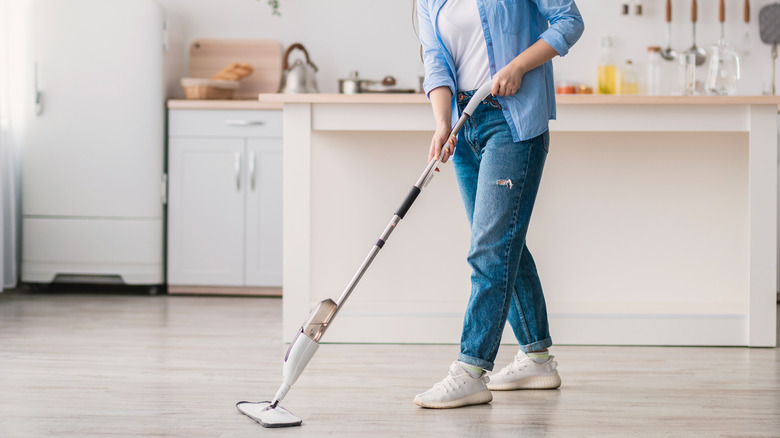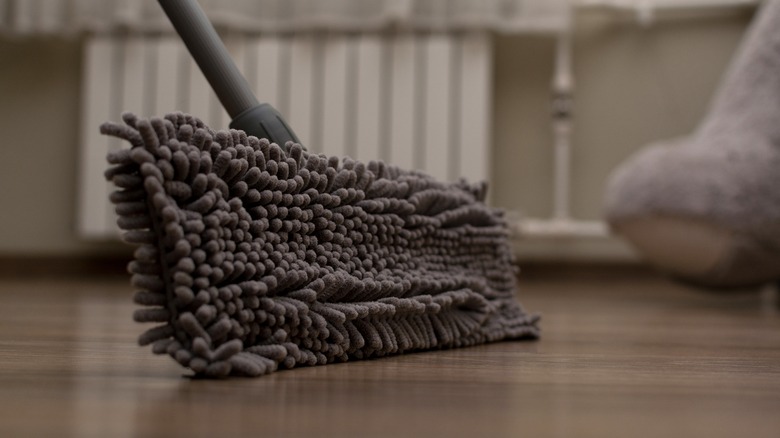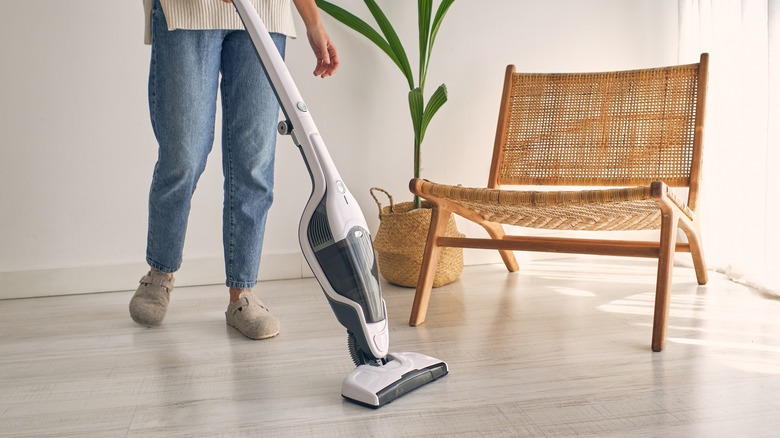The Essential Cleaning Tip That Prevents Unnecessary Scratches On Laminate Floors
Laminate floors are often chosen for their durability, but even they are not impervious to damage if not properly cared for. Certain abrasive cleaners can strip away the laminate's protective layer, leaving the floors vulnerable to damage from everyday traffic and at risk for scratches. Moreover, even a vacuum with a beater bar or brush attachment can unintentionally blemish your laminate floors, particularly if they have stiff or worn bristles. Nevertheless, there's a safe way to clean laminate floors properly to maintain the protective sheen and your home's aesthetic appearance. The next time you're ready to clean these floors, consider dry mopping.
Dry mopping is a great way to remove dirt and debris without introducing water to your laminate flooring. This is important because excessive water can cause damage, leading to warping or swelling and necessitating repairs. Furthermore, dry mopping is gentle, as it utilizes a microfiber mop or cloth to trap dust and dirt particles without scratching the floor. It also foregoes using harsh chemical cleaners that could damage the floor with repeated use. Lastly, dry mopping your floors is incredibly efficient since it doesn't require any preparation of cleaning solutions or waiting for the floor to dry. It's a great way to protect your floors and prevent the buildup of grime or dirt that can dull their finish over time.
How to dry mop your laminate floors
When it looks like your laminate floors need to be tended to, break out the dry mop to restore your flooring's shine. The best mop to use on these types of floors is a microfiber dry mop because it's gentle yet effective in collecting dust, dirt, and grime while protecting the surface of your laminate floors. Before you start, you may even want to vacuum the floor; just be sure to use a soft brush attachment and not the roller base, as that may scratch the laminate's surface.
Once you've tackled the larger debris, you can start dry mopping. Start in one corner of the room and work towards the opposite corner, using smooth, overlapping strokes to ensure you cover the entire surface. Concentrate on areas with higher foot traffic or visible dirt or grime. Try not to use too much pressure and let the microfiber do the hard work of trapping the dust and dirt.
Periodically throughout the process, check the condition of the microfiber cloth. If it looks dirty, it's a good idea to swap it out with a clean one so you don't spread the dirt across your space. Once you've finished, wash the microfiber mop according to its manufacturer's instructions to keep it clean for next time.
Avoid cleaning laminate floors like this
Dry mopping is the safest and most effective way to tackle your laminate floors and prevent scratches or other damage. It may be tempting to use other products, but you should avoid other cleaning solutions for laminate floors, as they can lead to damage that may require repairs or replacements. For example, never use abrasive materials like steel wool or scrub brushes on laminate flooring. These materials will wear away the protective layer, scratching the material and facilitating more damage from routine foot traffic or furniture movement. Additionally, these abrasive tools may dull the appearance of laminate over time.
In addition to abrasive tools, you'll want to avoid harsh chemicals and strong solutions when cleaning and polishing your laminate floors. Ammonia or bleach-based cleaners will also degrade the laminate's protective coating, leading to the same weakened surface that is vulnerable to damage. At the same time, with repeated use, chemicals can discolor or fade the laminate, compromising its shiny aesthetic.
Finally, when cleaning laminate flooring, it's best to avoid moisture if possible. While a damp cloth is sometimes necessary to remove tough stains or buildup, excessive moisture will seep into the seams and edges of laminate planks, resulting in swelling or warping. Consequently, it's best to avoid wet mopping and steam cleaning and only use water or laminate-safe liquids for spot cleaning or damp mopping. Always dry the floors immediately after to avoid any water damage.


